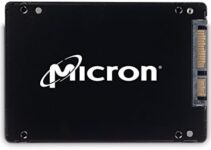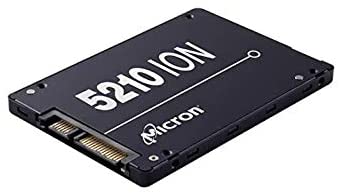- Micron stock is performing well despite poor guidance.
- Micron reported an EPS beat and a revenue miss.
- The company cut revenue guidance for the current quarter by as much as a third.
How bad was it? It was bad. The market had been expecting Micron Technology (MU) to unveil a poor quarter, and the maker of digital storage and memory devices obliged. Micron’s quarterly report missed on revenue but beat on earnings for the fiscal fourth quarter ending in August, but a major cut to the next quarter’s revenue was the primary surprise.
Instead of meeting guidance for the fiscal first quarter, which ends in November, management said to expect revenue between $4 and $4.5 billion and earnings per share (EPS) between $-0.06 and $0.14. Wall Street had been expecting fiscal Q1 performance of $6.02 billion in sales and EPS of $0.87.
Micron stock FQ1 guidance
Despite the surprising guidance cut, Micron stock barely budged. Even now in Friday’s premarket, Micron is down just 1.6% at $49.20. Yes, despite cutting revenue guidance for the current quarter by as much as a third, Micron stock has given up a pittance. The major reason for this is that Micron was already trading at such as low price-to-earnings ratio that there is little room for multiple compression. Its trailing PE ratio is below 6, while industry MVPs like Advanced Micro Devices (AMD) and Nvidia (NVDA) trade at trailing PEs close to 28 and 33, respectively.
If you are a Micron shareholder, then you can thank Mr. Market. This horrible guidance seems to have already been priced in. Indeed, Citi had already released a negative note prior to the release betting that Micron would need to trim capex spending by as much as 40%. That note seemed overly pessimistic at the time, but management said on the call that they have decided to cut 2023 equipment capex by closer to 50%.
“Our technology and manufacturing leadership in both DRAM and NAND, deep customer relationships, diverse product portfolio, and strong balance sheet put Micron on solid footing to navigate the weakened near-term supply-demand environment,” said Micron CEO Sanjay Mehrotra. “We are taking decisive steps to reduce our supply growth including a nearly 50% wafer fab equipment capex cut versus last year, and we expect to emerge from this downcycle well-positioned to capitalize on the long-term demand for memory and storage.”
The market for dynamic random access memory (DRAM) and NAND (non-volatile flash memory storage) products has been cratering as consumer demand for personal electronics has reduced post-pandemic, and the outlook looks poor well into 2023.
Micron stock FQ4 earnings
Micron’s fiscal Q4 earnings drew little fanfare and were mixed. The company produced $1.45 in EPS compared to analyst projections for $1.37, so this was a clear beat. Revenue of $6.64 billion missed estimates for $6.78 billion however.
This was of course well down from the year-ago period when Micron produced $2.42 per share on $8.27 billion. Most analysts have chalked that up to the heavy demand for PCs and electronics from folks staying at home during the height of Covid-19. Most shareholders are used to this type of activity. 2018 saw record revenue but was followed by a major downturn in sales during 2019. Then, as we all know, the pandemic brought back back demand in a major way. This is a cyclical stock that sells a commoditized product, and that is much of the reason why it sells so cheaply.
A clear moment of positivity for the quarter appeared in the gross revenue margin. Micron offered up a 40.3% gross margin in the quarter, while Wall Street had expected 39.7%. Sixty basis points is nothing to scoff at.
Mehrota also stuck to his guns concerning longer-term capex. He said that Micron remained on track to spend close to $40 billion over the next decade to bring more manufacturing onshore. Mehrota also was quite optimistic about Micron’s new fleet of products.
“In fiscal Q4, we led the industry again in introducing our 232-layer NAND, becoming the first company to enter volume production on a node with more than 200 layers,” Mehrota said. “We also remain on track to begin the ramp of our 1-beta DRAM node in manufacturing by the end of calendar 2022. Both the 1-beta DRAM node and 232-layer NAND node will provide us with robust cost reduction when they ramp in high volume.”
In related news, the Trade Minister of Japan announced a $322 million contract with Micron for the latter to develop and manufacture advanced memory chips at a factory in Hiroshima.
Micron stock forecast
Despite the pessimistic outlook for Micron stock, this may be a great time to buy. JPMorgan arrived at a similar conclusion earlier last month when it chose Micron as one of its top three memory chip stocks to benefit from the return of demand.
“As the memory cycle is getting shorter, we recommend investors buy memory stocks during an [EPS] downward revision cycle when a pessimistic view is prevailing,” the JPMorgan analysts wrote. As we can see from the last 24 hours, even poor guidance is not leading to a major sell-off.
More significantly the daily chart below shows that MU stock was at the bottom of its cycle, and the Moving Average Convergence Divergence (MACD) indicator seems to be showing a bullish crossover. With the share price already above the 9-day moving average, the 21-day moving average at $53 could offer resistance. This seems unlikely though since it is so close and Micron’s earnings release is behind it. A break above the 21-day will send it up toward the descending top trendline.
Long-term support remains at $43, and short-term support sits at $48.50.
Micron daily stock chart
Information on these pages contains forward-looking statements that involve risks and uncertainties. Markets and instruments profiled on this page are for informational purposes only and should not in any way come across as a recommendation to buy or sell in these assets. You should do your own thorough research before making any investment decisions. FXStreet does not in any way guarantee that this information is free from mistakes, errors, or material misstatements. It also does not guarantee that this information is of a timely nature. Investing in Open Markets involves a great deal of risk, including the loss of all or a portion of your investment, as well as emotional distress. All risks, losses and costs associated with investing, including total loss of principal, are your responsibility. The views and opinions expressed in this article are those of the authors and do not necessarily reflect the official policy or position of FXStreet nor its advertisers. The author will not be held responsible for information that is found at the end of links posted on this page.
If not otherwise explicitly mentioned in the body of the article, at the time of writing, the author has no position in any stock mentioned in this article and no business relationship with any company mentioned. The author has not received compensation for writing this article, other than from FXStreet.
FXStreet and the author do not provide personalized recommendations. The author makes no representations as to the accuracy, completeness, or suitability of this information. FXStreet and the author will not be liable for any errors, omissions or any losses, injuries or damages arising from this information and its display or use. Errors and omissions excepted.
The author and FXStreet are not registered investment advisors and nothing in this article is intended to be investment advice.


